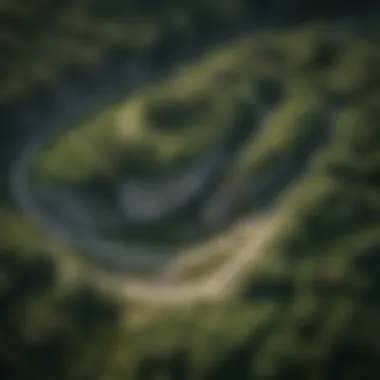Exploring the Rock House Trail: A Detailed Analysis


Intro
The Rock House Trail exemplifies the intricate interplay of ecological systems within forest environments. This natural feature not only captures the wonders of biodiversity but also stands as a testament to human interaction with these vital ecosystems. Understanding the various elements of this trail will provide insights into its geographical characteristics, the species it supports, and the recreational opportunities it affords.
Understanding Woodland Ecosystems
The Rock House Trail operates within a larger framework of woodland ecosystems. These forests serve as critical habitats for countless species, ensuring a rich tapestry of life that flourishes through complex interrelations.
Importance of Biodiversity in Forests
Biodiversity refers to the variety of life found in a particular ecosystem. It plays a crucial role in maintaining ecological balance. High levels of biodiversity can enhance resilience against environmental change and stressors.
Research has shown the following benefits of biodiversity in forests:
- Enhanced productivity: Diverse species often have complementary roles that improve overall ecosystem productivity.
- Increased stability: Ecosystems with varied species are less susceptible to collapse under stress.
- Greater resilience: Biodiverse systems can recover more quickly from disruptions, whether natural or human-induced.
Role of Forests in Climate Regulation
Forests are pivotal in regulating the Earth’s climate. They sequester carbon dioxide, thus mitigating the effects of climate change. The Rock House Trail, like many woodland areas, plays its part in this significant process.
Forests contribute to climate regulation by:
- Carbon storage: Trees absorb CO2 during photosynthesis, storing carbon in biomass and soil.
- Temperature regulation: Forest canopies maintain cooler temperatures in their environment, influencing local weather patterns.
- Water cycle management: Forests help regulate the hydrological cycle, ensuring a continuous supply of fresh water.
"Healthy forests are essential for sustaining life on Earth, influencing both local and global climates."
Sustainable Forestry Practices
Understanding sustainable forestry practices is crucial for the long-term health of trails such as the Rock House. These practices aim to balance ecological integrity with human needs.
Principles of Sustainable Forestry
Sustainable forestry encompasses various principles:
- Conservation of biodiversity: Emphasis is placed on protecting multiple species within forest environments.
- Forest health maintenance: Regular assessments ensure the forest maintains a natural balance, free from excessive pests or diseases.
- Community involvement: Engaging local communities in forest management fosters stewardship and accountability.
Case Studies of Successful Implementations
Investigating successful forestry practices provides a foundation for future efforts. For instance, the White Mountain National Forest has implemented a rigorous management approach that focuses on restoration ecology and community education initiatives. The results have led to improved biodiversity and stronger community ties to natural resources.
Woodland Stewardship Techniques
Effective stewardship of trails like the Rock House relies on specific management techniques.
Forest Management Plans
A well-defined forest management plan is critical. It should include:
- Regular monitoring and assessment: This involves tracking the health of the ecosystem to identify risks.
- Restoration efforts: Active restoration of degraded areas promotes ecological balance.
- Public education: Informing visitors about the importance of conservation encourages responsible use of the trail.
Conservation Strategies
Several strategies can enhance conservation efforts:
- Habitat protection: Safeguarding areas critical for species survival.
- Invasive species management: Controlling non-native species that threaten native biodiversity.
- Community restoration projects: Engaging local volunteers in hands-on conservation activities encourages a deeper connection to the land.
Foreword to the Rock House Trail
The Rock House Trail serves as a unique entry point into the interconnected worlds of ecology, recreation, and historical significance. Understanding this trail is essential not just for those who hike but also for professionals in forestry and environmental studies. The trail embodies the delicate balance between human activity and natural heritage, making it a poignant study site for conservationists.
A detailed analysis of Rock House Trail reveals its importance in promoting awareness surrounding biodiversity and sustainable practices. As urbanization continues to threaten natural habitats, trails like this offer a refuge for numerous species and allow humans to reconnect with the environment. This section will provide a solid foundation for the subsequent exploration of geographical context, biodiversity, and recreational opportunities associated with the trail.
Overview of the Trail


The Rock House Trail is distinguished by its well-defined paths and breathtaking views. Nestled within a forested landscape, it provides access to diverse ecology and rich historical narratives. The trail spans approximately 4.5 miles, winding through various terrains that highlight the area’s natural beauty.
Hikers can expect an array of challenges, from easy walks to moderately difficult sections that require careful navigation. Points of interest along the way include unique rock formations, streams, and panoramic overlooks that can enhance the hiking experience. Understanding the structure of the trail assists hikers in planning their visit, ensuring they can optimize their experience while respecting the environment.
Location and Accessibility
The Rock House Trail is conveniently located near various urban centers, yet it feels worlds apart from the hustle and bustle of city life. Located within the jurisdiction of national forestry land, the trail is accessible year-round. Visitors can enter from multiple access points, all of which are well marked.
Getting there is uncomplicated. Major highways lead to local roads, which are maintained to ensure smooth travel conditions. Public transportation options are limited, but carpools and community drives are common among local hiking groups. Adequate parking facilities are available at designated trailheads, which help manage the flow of visitors to minimize ecological disturbance. This accessibility allows a variety of individuals, from families to seasoned outdoor enthusiasts, to engage with the natural world.
Geographical Context
Understanding the geographical context of the Rock House Trail is essential for appreciating its ecological and recreational value. Location plays a pivotal role in determining the types of flora and fauna present, as well as influencing visitor engagement and trail sustainability. The interplay of various environmental factors such as climate, elevation, and soil composition directly impacts biodiversity, making this section critical for comprehending the trail's ecosystem.
The geographical features of the area contribute significantly to the landscape's beauty and ecological richness. They offer various recreational opportunities and serve as vital habitats for numerous species. By examining the terrain and geological elements of the Rock House Trail, one can grasp how these factors support the trail's vibrant biodiversity and promote active visitor participation within the natural setting.
Terrain and Landscape Features
The terrain along the Rock House Trail is diverse, including rolling hills, rocky outcrops, and lush woodlands. These variations create microenvironments that host distinct plant and animal communities. Higher elevations provide different climatic conditions, which contribute to diverse vegetation patterns, while valley areas may support wetter soils and different ecosystems.
Key features of the terrain include:
- Varied elevation levels which support a range of habitats
- Rocky formations that influence soil drainage and moisture retention
- Dense forests that provide shelter for wildlife and serve as recreational areas for visitors
The landscape not only enriches the visual appeal but also promotes ecological interactions among species. For example, the presence of certain tree species can create suitable conditions for understory plants and wildlife, thus maintaining the complexity of the ecosystem.
Geological Significance
From a geological perspective, the Rock House Trail is essential for understanding regional geology. The trail showcases various rock formations and soil types that reveal the area's geological history. By studying these formations, one can uncover the processes that shaped the landscape, such as erosion and sediment deposition.
Geological aspects include:
- Sedimentary rock layers: Indicating ancient water bodies and evolving ecosystems.
- Fossil evidence: Providing insights into past life forms that existed in the area.
- Mineral deposits: Offering clues about the natural resources that have historically attracted human activities.
This understanding not only enriches visitors' appreciation of the trail but also presents valuable insights for conservation efforts. As geology plays a vital role in biodiversity, recognizing the geological significance aids in the responsible management of the Rock House Trail and ensures its integrity for future generations.
"Exploring the geological context of a trail is as important as appreciating its natural beauty. It provides us critical insights into our earth's history and conservation duties."
Biodiversity Along the Trail
Biodiversity is critical to understanding the health of any ecosystem, including the Rock House Trail. Analyzing the various life forms present along this trail reveals complex interdependencies, which can illustrate the resilience and vitality of the area. A rich biodiversity enhances ecosystem productivity and provides numerous benefits, from food sources to recreational opportunities.
Key considerations regarding biodiversity include its direct effects on human well-being through ecosystem services, such as clean air, soil fertility, and water purification. Efforts to conserve these diverse life forms can lead to more sustainable practices in forestry and land management.
Flora: Unique Plant Species
The flora along the Rock House Trail includes various unique plant species that have adapted to the region's specific climate and soil conditions. Species such as the Eastern Hemlock and Mountain Laurel thrive here, offering insights into the biological richness of the ecosystem.
- Eastern Hemlock: This tree species provides shade and helps maintain soil moisture, allowing undergrowth plants to flourish.
- Mountain Laurel: Known for its beautiful flowers, it also acts as a vital source of nectar for local pollinators, particularly bees.
Understanding these unique plant species is crucial for making informed decisions regarding conservation initiatives along the trail. Protecting these plants helps maintain the overall health of the ecosystem, supporting both flora and fauna.
Fauna: Wildlife Observation Opportunities
The diversity of fauna along the Rock House Trail presents significant wildlife observation opportunities. Various species inhabit this area, ranging from birds and mammals to amphibians and insects. Birdwatchers may spot species like the Scarlet Tanager and the Black-capped Chickadee, while hikers might encounter Red Foxes or White-tailed Deer.
Recording wildlife sightings can provide valuable data for ecological research. Exciting encounters with wildlife can add a sense of wonder to any visit. However, it is critical to maintain distance and respect their natural habitats to ensure their wellbeing.
Ecosystem Services Provided by the Trail
The Rock House Trail's unique ecosystem offers a number of vital services that benefit not just wildlife but also the surrounding human communities. These services include:
- Carbon Sequestration: The trees absorb carbon dioxide, helping mitigate climate change.
- Soil Erosion Control: Plant roots stabilize the soil, preventing erosion during heavy rains and protecting waterways.
- Pollination Services: Native plants provide food and habitat for pollinators, essential for the reproduction of many crops and wild plants.


"Healthy ecosystems are the foundation of our communities, providing essential services that sustain life."
In summary, understanding the biodiversity along the Rock House Trail is crucial. It reveals the ecological integrity of the region, and highlights the need for conservation efforts to ensure its sustainability. A comprehensive analysis of flora, fauna, and the services provided helps inform management strategies that align with ecological and community well-being.
Recreational Activities on the Trail
In the context of the Rock House Trail, recreational activities serve multiple purposes. They not only allow visitors to engage with the rich biodiversity of the area but also promote physical health, mental well-being, and environmental stewardship. These activities gather people who appreciate nature, encourage social interaction, and foster a sense of community. Understanding these elements is vital for both trail users and stewards to enhance user experience while ensuring the ecosystem’s sustainability.
Hiking and Nature Walks
Hiking and nature walks along the Rock House Trail provide a direct connection to the environment. As individuals navigate through diverse terrains, they can observe different species of flora and fauna. The simplicity of walking allows for a personal and intimate interaction with the landscape. Visitors are often left in awe of the varying heights of the trees, the textures of the rocks, and the sounds of wildlife.
- Health Benefits: The physical act of hiking is beneficial for cardiovascular health and muscle development. Additionally, being in nature significantly reduces stress levels and improves mental clarity.
- Considerations: It is key to be aware of one’s own limits. Some sections of the trail can be steep or uneven. Proper footwear and hydration are essential for a safe experience.
Photography and Artistic Opportunities
The Rock House Trail is a treasure trove for photographers and artists alike. The unique landscapes offer countless opportunities for capturing stunning visuals. The interplay of light, shadow, and natural colors can inspire numerous creative expressions.
- Wildlife Photography: Birdwatchers and wildlife photographers can often find subject matter waiting around each corner. Still images can often tell stories that words cannot.
- Artistic Expression: Painters, sketch artists, and other creatives can find inspiration throughout the trail. The varying environments contribute to a scenario which is perfect for capturing feelings that transcend verbal expression, and results in a deeper appreciation of the trail's ambiance.
Educational Field Trips
Educational field trips along the Rock House Trail serve a dual purpose: they are an opportunity for learning and a chance to raise awareness about conservation. Schools, universities, and nature organizations frequently utilize the trail to provide hands-on experiences in ecology and environmental studies.
- Curriculum Integration: These trips can be integrated with subjects like biology, geology, and environmental science, allowing participants to apply their knowledge in a real-world context.
- Stewardship Education: Participants often learn about the importance of conservation and responsible trail use. Field trips can reinforce the connection between humans and nature, fostering a sense of responsibility and stewardship that can last long after the trip concludes.
In summary, recreational activities on the Rock House Trail offer enrichment in various forms. They contribute not only to individual well-being but also to the broader understanding of and respect for the trail’s natural environment. As visitors engage with both the trail and each other, they create a dialogue that encourages the preservation of such remarkable ecosystems.
Cultural and Historical Significance
The cultural and historical significance of the Rock House Trail cannot be overstated. This trail provides not only a pathway through diverse ecosystems but also serves as a living archive of human history and connection to nature. Understanding this significance is essential for appreciating the intertwined relationships between human practices and natural landscapes.
Indigenous Connections to the Land
Indigenous communities have maintained a profound connection to the land surrounding the Rock House Trail for generations. This relationship is rooted in a deep understanding of the ecological systems. Native tribes often regard these areas as sacred. They have not only utilized the resources available but have also nurtured and respected the environment.
Cultural practices such as gathering plants for food and medicine are integral to these communities. Each species within this ecosystem is significant and contributes to their rich traditions.
Some key elements of these connections include:
- Traditional Ecological Knowledge (TEK): Indigenous knowledge systems that inform sustainable resource management.
- Cultural Heritage: The trail embodies stories, traditions, and practices passed down through generations.
- Ceremonial Significance: Certain parts of the trail may hold spiritual value, hosting rituals that honor life-giving resources.
Understanding these connections aids in recognizing the importance of preserving both the trail and the culture that thrives alongside it.
Historical Usage of the Trail
Historically, the Rock House Trail has served various functions that reflect the human interactions with the natural world. From its early usage by Indigenous peoples to its current state as a recreational area, this trail encapsulates layers of history.
In the colonial period, the trail became part of pathways used by settlers and explorers. Over time, it transitioned into more focused uses:
- Transportation Route: Early settlers utilized the trail for travel and trade, linking important resources and communities.
- Recreational Use: In the 20th century, the trail saw a shift toward recreational activities, promoting hiking and nature appreciation.
- Research and Education: Today, it also serves as a site for environmental research and educational programs, emphasizing conservation.
The evolution of the Rock House Trail mirrors broader societal changes and highlights the enduring relationship between people and nature.
This trail stands not only as a physical route but as a testament to the adaptability and resilience of both nature and human culture.
Conservation and Stewardship
Conservation and stewardship are crucial elements in maintaining the integrity of the Rock House Trail ecosystem. These concepts encompass not only the protection of the natural environment but also the sustainable management of resources that ensure future generations can enjoy and learn from these landscapes. The trail exemplifies a habitat that supports biodiversity while also serving as an area for recreation and education. Balancing these needs helps to preserve the trail's unique attributes.
Challenges Facing the Trail Ecosystem
The Rock House Trail faces numerous challenges that threaten its ecological health. These include invasive species that disrupt local flora and fauna, erosion caused by foot traffic, and pollution that degrades air and water quality. Each of these issues can have significant repercussions for the ecosystem. For instance, invasive plants can outcompete native species, leading to a decline in biodiversity. Similarly, erosion affects soil stability and affects habitat quality for many organisms.


Additionally, increased human activity can lead to habitat fragmentation. This is detrimental as it disrupts wildlife movement and breeding patterns. Monitoring and addressing these challenges require collaboration among local conservation groups, government agencies, and the community.
Best Practices for Trail Preservation
Implementing best practices for trail preservation is essential to address the challenges mentioned above. Some effective strategies include:
- Establishing clear trail markers: This helps guide users along designated paths, reducing off-trail exploration that can lead to habitat damage.
- Using sustainable materials in trail construction: Utilizing materials that blend into the landscape can minimize ecological disruption.
- Regular maintenance activities: Conducting periodic checks for trail integrity and erosion control can help maintain optimal conditions.
- Community education programs: Providing information on the importance of conservation can foster a sense of responsibility among visitors.
By adopting these best practices, managers and users of the Rock House Trail can work together to protect its diverse ecosystems while ensuring a positive experience for all who visit.
Visitor Guidelines and Responsibilities
The significance of visitor guidelines on the Rock House Trail cannot be understated. These guidelines serve as a framework for responsible interaction with the natural environment. By adhering to these guidelines, visitors can help maintain ecological balance and promote sustainable practices. This is essential given the ecological sensitivity of the area and the numerous recreational activities it supports.
Leave No Trace Principles
The Leave No Trace principles are integral to responsible outdoor ethics. They consist of seven foundational concepts designed to minimize human impact on wilderness areas:
- Plan Ahead and Prepare: Understanding the trail's specifics and preparing adequately prevents unexpected challenges, ensuring safety and enhancing the experience.
- Travel and Camp on Durable Surfaces: Stick to established trails and campgrounds. This preserves sensitive areas and reduces erosion and habitat destruction.
- Dispose of Waste Properly: Pack out what you pack in. This includes all trash, leftover food, and personal waste. Ensuring no waste is left behind is crucial for the health of the ecosystem.
- Leave What You Find: Do not remove rocks, plants, or historical artifacts. This maintains the natural beauty and historical integrity of the trail.
- Minimize Campfire Impact: Use a stove for cooking instead of a fire. If fires are allowed, keep them small and contained to established fire rings.
- Respect Wildlife: Observe animals from a distance, avoid feeding them, and never disturb their habitats.
- Be Considerate of Other Visitors: Keep noise levels down and be friendly to other adventurers to enhance everyone's experience.
Incorporating these principles into outdoor activity not only protects the Rock House Trail but also ensures that future visitors can enjoy it in its pristine state.
Respecting Wildlife and Natural Resources
Understanding how to respect wildlife and natural resources is essential for every visitor. The Rock House Trail is home to diverse flora and fauna, each playing a role in the ecosystem. Respect is vital in maintaining this balance. Here are several key aspects to consider:
- Observe, Don’t Interfere: Enjoy viewing wildlife, but maintain a safe distance. Feeding animals disrupts their natural foraging behaviors and can lead to dependency on human-provided food sources.
- Avoid Disturbing Habitats: Be mindful when moving through the terrain. Stepping off the trail can damage delicate plant life and disturb the nesting and feeding behaviors of wildlife species.
- Report Issues: If you observe unsafe practices or potential dangers to wildlife, such as litter or injured animals, report them to appropriate authorities. Ensuring the safety of the trail involves shared responsibility.
Future Developments and Initiatives
The ongoing evolution of the Rock House Trail points toward a more inclusive and enriching experience for all who visit. This section delves into the significance of these developments, highlighting their potential benefits and the critical considerations that arise from them.
Potential Enhancements to User Experience
Improving user experience on the Rock House Trail is paramount. Enhancements may include upgrading trail markers for better navigation, introducing smart technology for real-time updates, or developing additional informational signage about geological and ecological aspects of the trail. These upgrades can help visitors engage more fully with their surroundings. The following are some possible enhancements:
- Interactive Maps: Providing QR codes on existing signs can lead to interactive maps on personal devices, aiding navigation and offering educational content.
- Observation Points: Developing designated areas for birdwatching and photography can enhance appreciation for the flora and fauna.
- Enhanced Accessibility: Implementing paths that are more wheelchair-friendly or adding rest areas can allow for a broader range of visitors to enjoy the trail.
These enhancements not only increase visitor satisfaction but also foster a greater connection between people and nature. By creating an informative and accessible environment, the trail becomes a platform for education and conservation awareness.
Ongoing Research and Monitoring Efforts
The significance of the Rock House Trail extends beyond recreation; it is a vital platform for ongoing research and monitoring. Various studies help assess ecological health, explore species diversity, and monitor the impacts of climate change on local ecosystems. Findings can inform conservation strategies and trail management practices. Some key areas of focus include:
- Biodiversity Studies: Documenting species presence and abundance helps gauge the ecological value of the trail, identifying potential conservation priorities.
- Ecosystem Monitoring: Regular assessments of soil quality, water quality, and vegetation health provide data essential for understanding environmental changes.
- Visitor Impact Surveys: Research into the effects of foot traffic assists in developing strategies to mitigate negative impacts on trail ecology.
Engaging with academic institutions leads to collaborative efforts in research, paving the way for innovative conservation approaches. This commitment to research exemplifies a proactive stance on preserving the trail's unique attributes.
"The Rock House Trail is not just a path through nature; it represents a commitment to ongoing research and an evolving understanding of ecosystems."
End
The conclusion section serves a crucial role in summarizing the insights drawn from the Rock House Trail's exploration. It is not merely an end but a synthesis that encapsulates the complex relationship between the ecosystem and human interaction within it. Understanding the trail fosters a greater appreciation of nature and highlights the necessity of sustainable practices.
Summarizing Key Insights
In revisiting the overarching themes discussed throughout the article, we find several key insights:
- Ecological Importance: The Rock House Trail's diverse ecosystems, including its unique flora and fauna, demonstrate the intricate balance of natural processes.
- Cultural Heritage: The historical significance of the trail deepens our comprehension of indigenous practices and the land's usage over centuries. Environmental values inherent in these traditions can inform modern conservation efforts.
- Recreational Opportunities: The trail offers numerous activities such as hiking, photography, and educational trips. These avenues enhance public engagement with nature while promoting awareness of environmental stewardship.
- Conservation Challenges: Recognizing the challenges faced by the trail, such as habitat degradation and invasive species, is vital. Thoughtful management strategies can address these issues, ensuring the trail's sustainability for future generations.
Encouragement for Engagement with the Trail
Engagement with the Rock House Trail is essential for fostering environmental consciousness. Visitors have an opportunity to truly connect with nature, observing the biodiversity firsthand. It is recommended that individuals participate in guided hikes or volunteer in conservation activities to further appreciate this remarkable ecosystem.
Moreover, maintaining a respectful attitude toward wildlife and its natural surroundings enhances everyone's experience.
Through personal interactions with the trail, individuals can develop a sense of responsibility and connection to the environment. The Rock House Trail is not just a natural feature; it is a living landscape that thrives on the engagement and consideration of its visitors. By participating actively, the community can contribute to its preservation, ensuring it remains a valuable resource for education, recreation, and research.
"A deep understanding of nature cannot be acquired in isolation; it requires contact with the living landscape."
In summary, the Rock House Trail invites all people to explore its offerings while encouraging sustainable practices. Engaging with this trail not only heightens personal awareness but also fortifies collective efforts in safeguarding our natural heritage.







